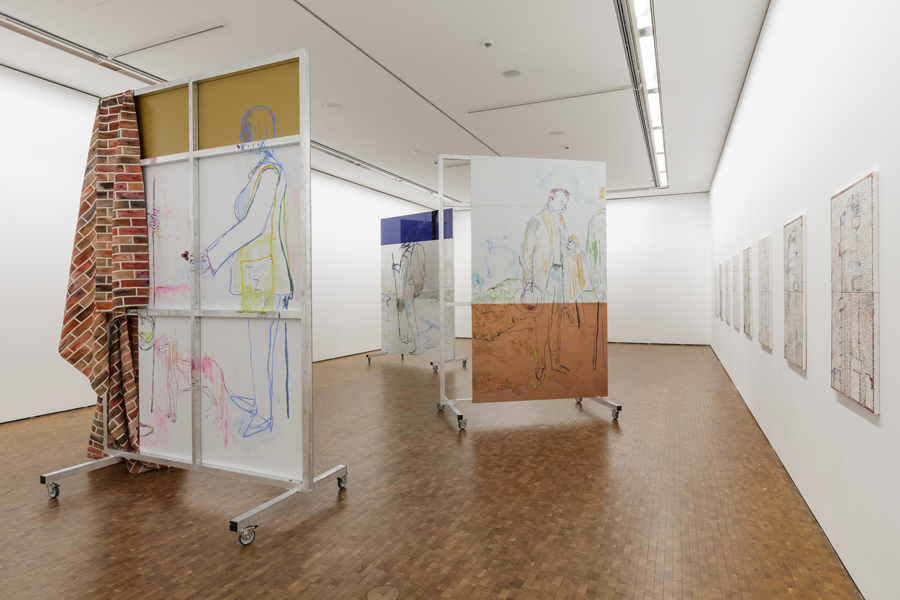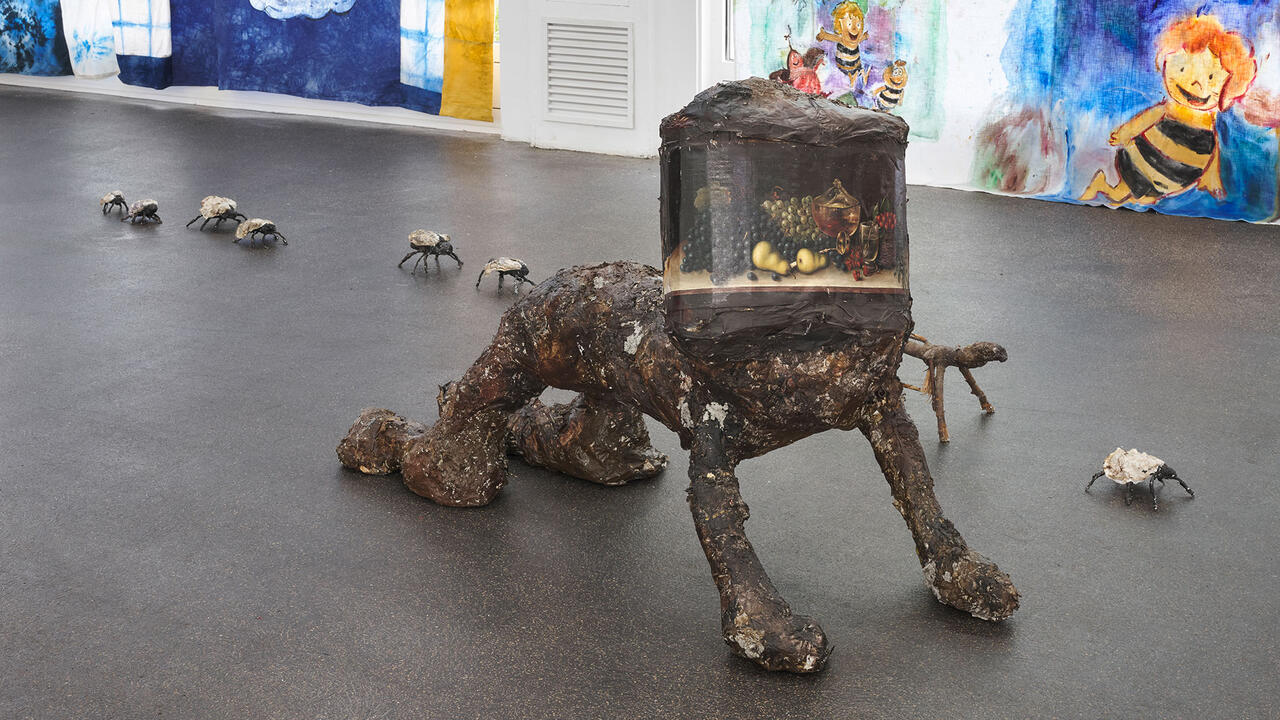Bad Bad Painting
Reena Spaulings, ‘bad painting’ and the institutionalization of Institutional Critique
Reena Spaulings, ‘bad painting’ and the institutionalization of Institutional Critique

‘HERE AND NOW’ is the title of a new series of exhibitions at Cologne’s Museum Ludwig. To date, there has been an intervention by Heimo Zobernig in the museum’s sculpture collection, a group show of artists under 40 titled ‘Home Visit’, which saw site-specific works installed in various private apartments across the city, and an exhibition of paintings by the New York artist collective Reena Spaulings entitled ‘HER AND NO’.
The outstanding feature of the latter, which for the most part was a largely conventional show, was the demonstrative ‘badness’ of the work. Even after close scrutiny of the individual works, the composition of the various series and the installation itself, my companion and I arrived at the same conclusion: This show and its components were bad – and intentionally so. This deduction prompted two questions: How, and to what end, did the exhibition find its way into a museum? And why should anyone go and see it?

The first question is comparatively easy to answer. Within the sophisticated art world, Reena Spaulings has a certain standing. Having first appeared in 2004 as the protagonist of ‘her own’ novel (which was authored by the exemplary artist collective Bernadette Corporation), Reena Spaulings, with the artist Emily Sundblad and the art critic John Kelsey at the helm, has become an established brand, bundling activities from operating an eponymous gallery on New York’s Lower East Side to art production.
Reena Spaulings owes much of its reputation to a certain ‘edginess’, which is combined with a certain ‘credibility’. This is based on its position within a long tradition of market- and institution-critical practice, which takes us from Marcel Broodthaers’s one-man museum to the legendary ‘gallery with attitude’, American Fine Arts. Run by Colin De Land, himself a champion of fictitious artists like John Dogg and the collective Art Club 2000, American Fine Arts had close ties with a the notorious Cologne art scene of the early 1990s, some of whom, including Merlin Carpenter, Stefan Dillemuth and Jutta Koether, continue to be part of the Reena Spaulings circle, and are represented by the gallery. This is an interesting tale, one that could certainly be told in more detail, but storytelling isn’t the point here.

Nor was it the exhibition’s intention. ‘HER AND NO’ collected together painted works into a presentation set on emphasizing the material qualities of painting itself – as both thing and commodity. (The text accompanying the show offered little by way of an explanation or highlighting the conceptual background.) The paintings themselves were, as mentioned, remarkably bad. Mostly coming in series of random/quantifiable variations in, say, colour and treatment, there were postcard views of the nearby Cologne Cathedral and Herzog & de Meuron’s 56 Leonard Street skyscraper in New York, rendered in Sunday painterly pointillism. Then there was a quotation of Gustave Courbet’s Le Rencontre (1854) (which depicts the painter, a collector and his servant meeting in the countryside), broken down into its constituent parts and spread across several mighty, moveable panels. The painting techniques applied were based not only on technical but also conceptual underperforming, thus apparently aiming even lower than the now-historical and successfully commoditized dialectic ‘badness’ of, for example, the 1980s artists associated with Martin Kippenberger and Albert Oehlen.

There was even more Kippenberger ‘flair’ in a series of portraits depicting art advisors apparently known within the contemporary scene. The series was hung together, but one of the portraits stood apart, mutating from a tableau into a table and quoting a work from Kippenberger’s 1987 show ‘Peter’, staged at Max Hetzler’s former Cologne gallery, for which he repurposed a monochrome Gerhard Richter work as the top of his table sculpture Model Interconti (1987). While this could be seen as an attempt to prove (intentionally and technically) ‘bad’ painting’s continuing ability to produce (conceptually and enjoyable) ‘good’ art, Reena Spaulings’ paintings seemed the results of an attempt to wholly abolish any and all ‘good’ whatsoever.
Bad painting is an artistic register just as well anchored in art histories of theory and practice as the notorious quoting, copying and parodying of appropriation art. In the late 1970s, the two represented the most interesting registers through which to challenge the status quo of artistic image making, the conceptual production of meaning, as well as the institution of art itself. But many years have passed since then, and what was once suited to challenging the status quo with critical intent, or to redefine it to progressive ends, has since become the status quo itself – an aesthetic and conceptual academism that is selling better than ever. And yes, as well as being a gallerist, the ‘artist’ Reena Spaulings is ‘really’ represented by a number of prestigious galleries. And yes, according to the courtesy labels at Museum Ludwig, most of the works – as bad as they were – were still available for purchase.

Here, too, the accompanying text has little to say, although it does note that a series of abstract pictures made by robot vacuum cleaners resemble J.M.W. Turner’s seascapes, a random reference that fails to elevate the mechanical automatism of Reena Spaulings’ pictures to any noticeable degree. Instead, they exist as visually insufficient ‘sites’ for a somewhat unsurprising conceptual manoeuvre. The text also claims that these works are ‘reflective of the system and self-deprecating’, which, granted, sounds like something written by a robot, albeit one whose camera has broken down. But on the earlier questions – why is any of this in museum and why should anyone go and see it? – it remains silent.
In order to wrest meaning from this presentation, one so fixated on the need to look and to find wanting, we must take another step back – more so because ‘HERE AND NOW’, as an institutional format, has a programmatic agenda, aiming to address fundamental issues of museum work via collaborations with artists. The exhibition series claims to be ‘an experimental format that critically examines conventions of presenting art in museums and questions the approach of its own institutional work.’ But what sounds like a noble objective, clearly indebted to a long-standing (and long-institutionalized) tradition of institutional critique, becomes increasingly difficult to achieve the more the responsibility for achieving it is pushed onto the featured artists themselves. Not for nothing did Reena Spaulings pragmatically counter this invitation with ‘HER AND NO’, a veritable affirmation of the prevailing institutional convention of wholeheartedly embracing conceptually and aesthetically ‘bad’ art. This is not self-deprecation. Instead, it is the unequivocal ‘NO’ of self-defence. After all, who would want to be used as a tool for commissioned institutional self-reflection?

Reena Spaulings address an important point with their gesture of refusal. In the course of the 1960s conceptualization of art, the link between ‘seeing’ and ‘understanding’ was identified as a fundamental problem. But however ‘conceptual’ visual art may have become as a result, our first encounter with a vast proportion of it remains just that: ‘visual’. As Lucy Lippard and John Chandler pointed out in 1967, the incubation phase of conceptual art: ‘As visual art, a highly conceptual work still stands or falls by what it looks like.’
Half a century later, this still applies, and it informs a number of questions as to Museum Ludwig’s presentation: Who would ‘get’ what is set on visual display here? Why should anyone go and see an exhibition that centres on collateral disappointment? What conception of a general public shapes an institution’s agenda, programming and communications?
It doesn’t reflect well on an institution’s self-image and competence when visitors are left alone with the ‘badness’ of an exhibition – a particular ‘badness’ that only reveals itself as explicable once said visitors have learnt about the exhibition’s historical context and the agenda that it was once meant to exemplify. But even then, this knowledge does not make the exhibition ‘good’ – nor does it make the work any better. It just makes for bad bad painting.
Translated by Nicholas Grindell
Main image: Reena Spaulings, Bonjour! (detail), 2017. Courtesy: © the artists





















